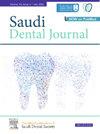Integrating Critical thinking and embracing Artificial Intelligence: Dual Pillars for advancing dental education
IF 2.3
Q3 DENTISTRY, ORAL SURGERY & MEDICINE
引用次数: 0
Abstract
Among various clinical skills, critical thinking (CT) is foundational for quality patient care. However, existing literature suggests deficiencies in applying analytical reasoning skills in healthcare education. As CT integration gains momentum in dentistry, the rapid advancement of artificial intelligence (AI) technologies introduces new dynamics. This article explores the potential impacts of emerging technologies of AI on the development and application of CT in the dental profession.
Methods
A narrative literature review of English-language publications was conducted using sources such as PubMed, MEDLINE, ScienceDirect, Wiley-Online-Library, and Oral-Health-Group. Our review focused on relevant articles published up to June 30,2024, representing a peak period of CT awareness. The search terms used included: “Critical thinking,” “healthcare,” “rubric,” “dental education,” and “Artificial intelligence.” No inclusion or exclusion criteria were applied. The search strategies aimed to synthesize collective healthcare experience in implementing CT in education, providing a cohesive understanding of the current state of CT and highlighting gaps in its integration in education.
Results
Strategies for incorporating CT into dental education are still developing. Although dental educators recognize the importance of CT-based curricula, barriers hinder effective implementation. Additionally, the rise of advanced technologies with human-like cognitive and non-cognitive capabilities necessitates agile, adaptable strategies to integrate CT in dental education. A simplified model is proposed for integrating AI into the development of CT skills at multiple levels in dental education. Furthermore, a rubric for assessing CT skills in problem-based learning is presented.
Conclusion
This review emphasizes the urgent need to strategically prioritize CT integration in dental education. Inadequate application of CT may increase the risk of AI misuse, and overreliance on AI could potentially undermine clinical decision-making. We propose that emerging technologies should be embraced as tools to enhance the development of CT skills while mitigating potential negative impacts. Plausible approaches to addressing this challenge are outlined.
整合批判性思维和拥抱人工智能:推动牙科教育的双重支柱
在各种临床技能中,批判性思维(CT)是优质患者护理的基础。然而,现有文献表明分析推理技能在医疗保健教育中的应用存在不足。随着CT集成在牙科领域的发展势头,人工智能(AI)技术的快速发展带来了新的动态。本文探讨了人工智能新兴技术对牙科行业CT发展和应用的潜在影响。方法采用PubMed、MEDLINE、ScienceDirect、wiley online - library、Oral-Health-Group等网站对英文出版物进行叙述性文献综述。我们的综述集中在2024年6月30日之前发表的相关文章,这是CT认知的高峰期。搜索词包括:“批判性思维”、“医疗保健”、“标题”、“牙科教育”和“人工智能”。未采用纳入或排除标准。搜索策略旨在综合集体医疗保健在教育中实施CT的经验,提供对CT现状的有凝聚力的理解,并突出其在教育中整合的差距。结果将CT纳入口腔教育的策略仍在发展中。虽然牙科教育工作者认识到ct为基础的课程的重要性,障碍阻碍了有效的实施。此外,随着具有人类认知和非认知能力的先进技术的兴起,需要灵活、适应性强的策略来将CT整合到牙科教育中。提出了一个简化的模型,将人工智能整合到牙科教育多层次的CT技能发展中。此外,还提出了一个评估基于问题的学习中CT技能的标准。结论强调在口腔教育中重视CT整合是当务之急。CT应用不足可能会增加人工智能滥用的风险,过度依赖人工智能可能会破坏临床决策。我们建议将新兴技术作为促进CT技能发展的工具,同时减轻潜在的负面影响。本文概述了应对这一挑战的可行方法。
本文章由计算机程序翻译,如有差异,请以英文原文为准。
求助全文
约1分钟内获得全文
求助全文
来源期刊

Saudi Dental Journal
DENTISTRY, ORAL SURGERY & MEDICINE-
CiteScore
3.60
自引率
0.00%
发文量
86
审稿时长
22 weeks
期刊介绍:
Saudi Dental Journal is an English language, peer-reviewed scholarly publication in the area of dentistry. Saudi Dental Journal publishes original research and reviews on, but not limited to: • dental disease • clinical trials • dental equipment • new and experimental techniques • epidemiology and oral health • restorative dentistry • periodontology • endodontology • prosthodontics • paediatric dentistry • orthodontics and dental education Saudi Dental Journal is the official publication of the Saudi Dental Society and is published by King Saud University in collaboration with Elsevier and is edited by an international group of eminent researchers.
 求助内容:
求助内容: 应助结果提醒方式:
应助结果提醒方式:


